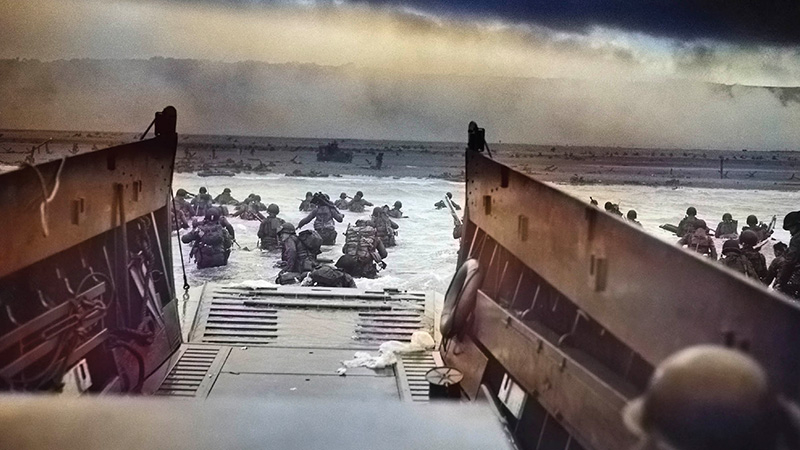Interwar and World War II
Driving Question: How did the horrors of World War II happen, and what conflicts did this war resolve or leave unresolved?
How does one world war lead to another? This lesson introduces key tools, events, and historical patterns, which will help you understand how global tensions and extremist ideologies led to the most devastating war in modern history.
Learning Objectives:
- Evaluate the international efforts at cooperation that followed the end of World War I.
- Understand how the rise of extremist ideologies during the interwar period helped cause World War II.
- Identify major changes and continuities in communities, networks, and production and distribution during and after the Second World War.
Vocab Terms:
- authoritarian
- eugenics
- fascism
- genocide
- Great Depression
- nationalism
- totalitarian
Opener: Interwar and World War II
To teach this lesson step, refer to page 2 of the Lesson 7.1 Teaching Guide.
A lot changed between the two world wars, but a lot also stayed the same. Compare these two maps as you begin this lesson.
Looking Ahead
To teach this lesson step, refer to page 3 of the Lesson 7.1 Teaching Guide.
Our Writing Guide emphasizes the importance of informal writing in the course.
Begin exploring the connections between World War I and World War II, and consider how past events shaped what came next for communities, nations, and global systems.
The Second World War
To teach this lesson step, refer to page 3 of the Lesson 7.1 Teaching Guide.
Check out our Reading Guide to remind you of the importance of the Three-Step Reading approach.
These resources introduce the key causes, turning points, and consequences of the Second World War while raising questions about what was resolved and what remained unfinished.
-
Guiding Questions
-
Before you read
Preview the questions below, and then skim the article. Be sure to look at the section headings and any images.
While you read
Look for answers to these questions:
- What were some of the major atrocities of the Second World War?
- How did the First World War help create the conditions for the Second?
- What events contributed to the outbreak of the Second World War?
- Which two countries emerged strongest after the war?
After you read
Respond to this question: Why is it important to study the horrors of the Second World War, even though they can be difficult to read about?
-
Guiding Questions
-
Before you watch
Preview the questions below, and then review the transcript.
While you watch
Look for answers to these questions:
- How was the scale of World War II different from World War I?
- What problems caused by the First World War contributed to the Second?
- How did economic and political instability lead to nationalism?
- What were some results of extreme nationalism and authoritarianism during the war?
- How did the number of democracies in the world change from 1930 to 1944?
After you watch
Respond to this question: Why did some democratic countries in Europe turn toward authoritarianism and nationalism in the 1930s?
Key Ideas
Framing Unit 7
To teach this lesson step, refer to page 5 of the Lesson 7.1 Teaching Guide.
Review the World History Frames Guide for tips on teaching the frames.
Understanding the causes and consequences of World War II requires a broader lens. This video and activity will help you use the course frames to identify change, continuity, and complexity during this global conflict.
-
Guiding Questions
-
Before you watch
Preview the questions below, and then review the transcript.
While you watch
Look for answers to these questions:
- What were internationalists hoping for after World War I?
- What problems did both capitalism and socialism face in the 1920s and 1930s?
- What was a main cause for the Second World War?
- What was the global outcome of the Second World War?
After you watch
Respond to this question: Do you think it is possible to nationalism to exist without producing extremism?
Key Ideas
Closer: Interwar and World War II
To teach this lesson step, refer to page 6 of the Lesson 7.1 Teaching Guide.
Take a look at the Openers and Closers Guide to find out more about why these important activities bookend our lessons.
In this 3-2-1 closing activity, you’ll review knowledge from previous lessons, reinforce current learning, and ask questions for understanding.
Reviewing for Organization and Language/Style
To teach this lesson step, refer to page 6 of the Lesson 7.1 Teaching Guide.
By suggesting revisions to someone else’s writing, you’ll get much better at identifying what makes strong writing. Make suggestions for improving organization and language/style—and then keep those suggestions in mind the next time you write.






